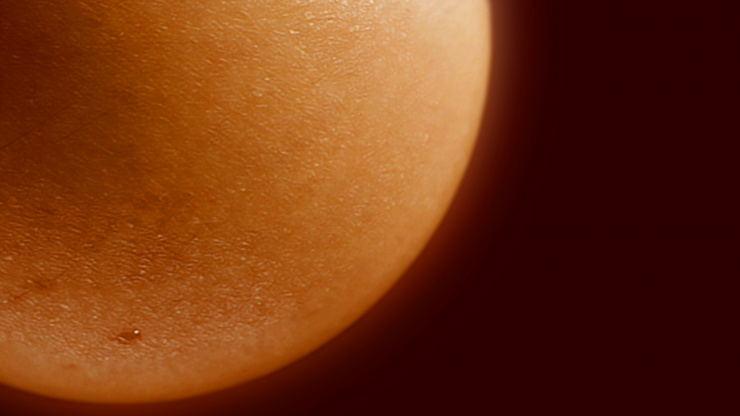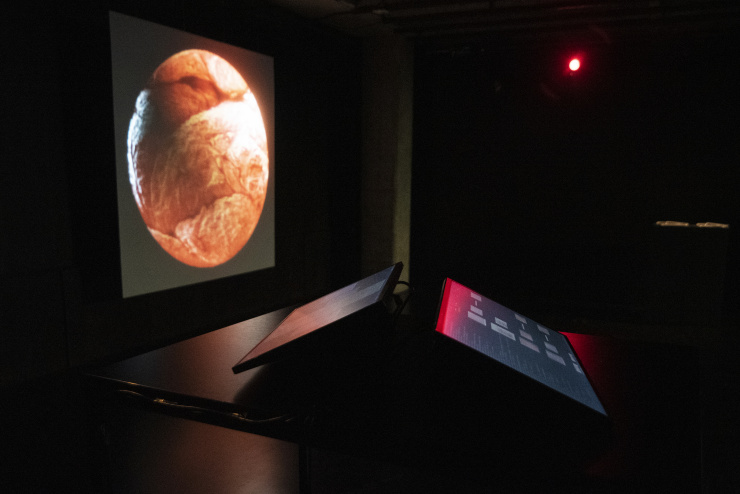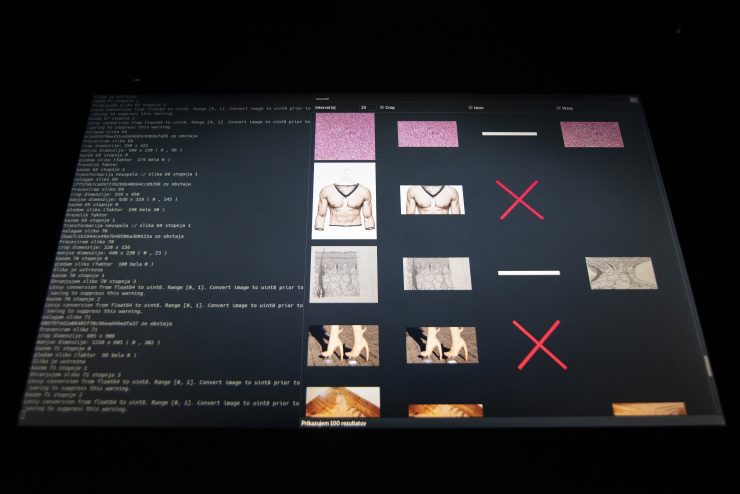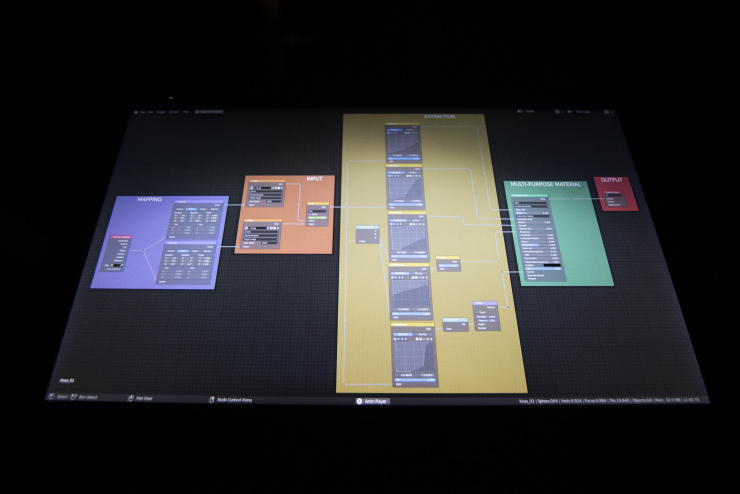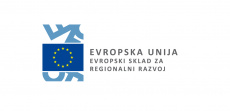Voranc Kumar: Surface
Installation
24 - 28 October 2019 @ osmo/za, Slovenska 54, Ljubljana (8th floor)
FB EVENT
In his project Surface, Voranc Kumar deals with the relationship between body and computer graphics. At the intersection of technology and epistemology, he explores the relation between the human body and computer program while replicating skin's visual characteristics (subsurface scattering).
The installation comprises a projection of a rotating sphere, on top of which images of skin are alternating, and a separate display of projection-generating algorithmic activities. As a base for simulation, the algorithm utilizes visual material generated by Google Image Search Engine from which it extracts these images. The search is delimited by keywords such as skin, human skin, skin surface, etc. In this juxtaposition, the situation between image and the concept of the body is not given, but rather produced by means of digital technology.
The skin acts as an interface, simultaneously organic and digital. We can understand digital technology as an inscription, read by either machine or by human. In this, we can recognize the similarity of the digital to the role of the body in the history of science on humans. In case of the development of medical science and clinical practice, the body was formed based on the relation between the inscription and its reading – the surface as a sign and a riddle of diseases and their causes, in case of penal and police practice on the relation between body signs and delinquencies.
Therefore, the body is not a universal form. It is a result of concrete ways of interpretation and extraction of knowledge on the depth of the body based on surface signs, such as medical diagnostics, surveillance techniques and – lastly – also the technology of computer graphics in its mimetic ambition.
Timeline
opening: 24 October, at 8.30PM
venue open: 25-28 October, 3-8PM
artist guided tour: 28 October, at 7PM
Past events
- International Festival of Computer Art IFCA, Maribor | October 11th – 18th, 2019 (curator: Tjaša Pogačar)
- konS modul, Novo mesto | July 5th – 24th, 2021
- konS modul, Velenje | February 7th – 26th, 2022
Gallery
Concept
Voranc Kumar's project Surface explores the relationships between the body and technology. He is interested in the relations between the body and computer graphics pertaining to the digital replication of the skin's visual characteristics. The installation comprises a projection of a rotating sphere, on top of which images of skin are alternating, and a separate display of projection-generating algorithmic activities. The skin acts as an interface – simultaneously organic and digital – which mediates the relationship of surface and depth, the visible and invisible as well. Within this, one can recognize the similarity between the medium of the body and the medium of the digital, which stands as the research base of the project.
The human body has never been merely human. The relation between technology and the body is a relation demarcated by the scope of a particular technology – concurrently as an intrusion into the corporeal interior and as a prolongation of the body into the exterior. Today, for example, we can hardly imagine a being who would not be ceaselessly attached to machines that invade it and morph its activity. This, of course, is a situation that propels several distinctively theoretical and artistic, utopian and dystopian imaginations, yet not without a long history. The merging of technology and body is in fact paleontologically and anthropogenically immanent.
According to Bernard Stiegler, the human, and by extension social and historical existence, is organological, reproducing by means of technical and material organs that are external to the person. Marshall McLuhan envisaged such an existence when he said that technology is an extension of our bodies, a continuation of our organs. Deleuze and Guattari also wrote about a collective body without organs as a technological reorganization of the body's both inherent and extrinsic organs.
This theoretical paradigm, which emerged with the advancement of modern electronic technologies, is synchronously still part of the political and artistic paradigm which in the mid-20th century positioned the body in the center of importance. The body became a point of resistance and performative construction or deconstruction of identity, which emanated especially in the artistic practices of performances. Conversely, towards the end of the century when digital and network technologies were increasingly pervading the quotidian life, Friedrich Kittler warned that we focus too much on the body and insufficiently on the electronic and software developments when we research media technologies. By doing so, he predicted the paradigm which, later to some extent, in the theory and understanding of media technologies, assumed primacy.
Although maintaining an immanent relationship between the body and technology, in Surface, Kumar avoids both the paradigm which comprehends the technology as an extension of the body as well as the paradigm which stems from the techno-mathematical comprehension of digital technologies. If the body shatters into a thousand points with an installation, recognized by both human and machine as the object of skin, a certain concept of the body and a certain concept of digital technology are dispersed as well.
Surface executes an epistemological operation: it adopts the digital processing as an apparatus of image production, perception and body interpretation, and as an extraction of the truth from the body. The body and technology are part of the same epistemological operation, which is also Kumar's genuine interest. The extraction of the truth about the body, as we know from the history of science, is the perforation of its surface – distinguishing signs on its surface and associating these marks with disease and delinquency or biopolitical profiling of genetic properties. Under such terms, even racism derives from the recognition of the bodily surface by establishing its racially interpreted depth. For Kumar, the body arises as an inscription, similar to the digital, which identifies and replicates the visual characteristics of the body. The body with its depth is a series of surfaces – and so is the digital.
Tracing a commonplace is also a fundamental way in which installation thematizes the link between the body and technology. Meaning the relation between the body and digital technology is duplicated. It is simultaneously situated both within the body and within digital technology – especially the history of the body as the history of interpreting the surface by various epistemological apparatuses. Kumar does not deal as much with the technological and social rift onset by digital technology, neither with the continuity of said technology with other interpretative apparatuses, but with the common epistemological foundation. Therefore, upon observing his work, the viewer must fathom that the author does not relinquish digital technology to poetic, critical, or any other kind of usage since he follows the question of the production of (re)cognition. The objects of the installation are consequently algorithmic procedures of recognizing the skin's traits. The question raised by Kumar is the question what is skin for an algorithm – how does an algorithm read the surface of a body.
We see what the algorithm sees for us. The algorithm utilizes Google Image Search Engine as a data repository, from which it extracts these images. The search is delimited by keywords such as skin, human skin, skin surface, etc. The pictorial material we observe is set by the author's algorithmic adaptation for rotating hemisphere projection. The automatized detection, selection, and projection of Google's skin is modified to parameters such as contrast, which the search engine and its techno-mathematical conception of skin assume to be suitable.
Perhaps we detect mostly white skin, maybe we see mainly healthy skin. If so, then we may notice that the recognition of skin as skin is an object of production and normalization – or algorithmic bias. The development of techno-mathematical logic of digital technology is profoundly interwoven with social and thus even power relations in their historic articulations. The questions posed by Surface do eventually amalgamate into the query how to understand the relation between power (in Foucault’s broader sense) and algorithmic technology. Kumar provides no explicit answer. By seeking a collective epistemological position of the body and digital technology, he attempts to discern the spot from which such a question – which will acquire its full gravity in the future – would be rendered possible.
About the author
Voranc Kumar(1990) holds a Master's degree in sculpture from the University of Ljubljana where he received Prešeren student award. Currently, Kumar is a doctorate student in philosophy at the Faculty of Arts in Ljubljana. His practice is spread between theatre, visual arts, and computer graphics. He is most active as a scenographer, video maker, visual artist and maker of 3D scenography and effects. In 2018, he presented with two solo exhibitions: A Few Minutes Later in Škuc Gallery and Landscapes and Maps in Gallery p74.
Concept: Voranc Kumar
Curator: Maja Burja
Text: Robert Bobnič
Translation: Žan Korošec
Programming: Jurij Podgoršek, Luka Frelih
Acknowledgment:Tjaša Pogačar
Production: Ljudmila Art and Science Laboratory and Projekt Atol Institute
Co-production: MKC Maribor
The project is supported by the Ministry of Culture, Municipality of Ljubljana, Department for Culture and Ministry of Public Administration. The project is part of EASTN-DC Network, which is co-funded by the Creative Europe programme of the European Union.
The Project KONS::Platforma for Contemporary Investigative Art was chosen on the public call for the selection of the operations “Network of Investigative Art and Culture Centres”. The investment is co-financed by the Republic of Slovenia and by the European Regional Development Fund of the European Union.

